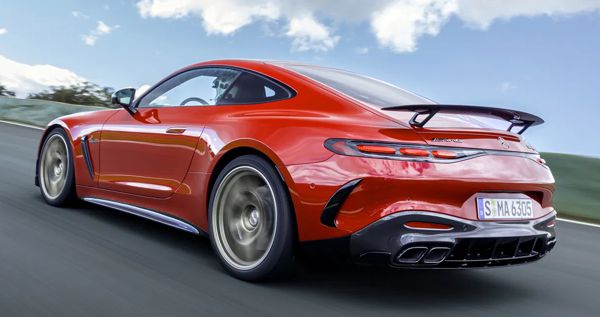Published
on 13
Dec 2023
|
All rights reserved.
|
|
 |
|
From
supercar evolves to 911-challenger and now a more traditional grand
tourer, is it the right path?
|
|
From SLS AMG to the first
generation AMG GT and now the second generation, you can see a big
shift of philosophy. The SLS was a front-engined supercar. It featured
gullwing doors, an all-aluminum chassis and 47:53 weight distribution,
thanks to putting the 6.2-liter V8 completely behind the front axle and
a double-clutch transaxle at the opposite end. Many of these features
were carried over to the first AMG GT, although the naturally aspirated
engine was replaced with a twin-turbo 4-liter V8, and the car was made
a little smaller and significantly cheaper, as it was repositioned to
target at Porsche 911. Somehow, the GT never quite succeeded in
matching the Porsche in sales, although it did win applause from
motoring journalists, especially the hardcore GT R and ultimately Black
series.
With the second generation AMG GT, the outgoing philosophy has been
scrapped. Now it has evolved into a more traditional grand tourer,
grows larger, much heavier, gets a pair of (very small) rear seats,
standard all-wheel drive and generally a softer character. To save
money, it shares most of the underpinnings with the new Mercedes SL,
which has been transferred to the AMG division and built on the same
production line.
While the GT is not exactly the coupe version of SL, it shares
everything mechanical with the roadster: powertrains, suspension,
chassis as well as interior and electronic technology. It shares the
roadster's 2700 mm wheelbase, while overall length is just a couple of
centimeters longer. At 4730mm long, it is a full size larger than the
old car, and this reflects on scale – kerb weight is 1895 kg, 325 kg
more than the old car!
 |
|
Mercedes’
designers shaped its rear such that it looks remarkably close to a 911
when viewing from behind.
|
|
Some other signs show that it is less thoroughbred than the old GT.
While the 4-liter twin-turbo V8 looks like the same, this version
employs wet sump instead of dry sump, so it is mounted not quite as
low. The rear-axle-mounted DCT of the old car is also abandoned,
replaced with a more conventional 9-speed MCT automatic that is bolted
right behind the engine. In addition to the standard all-wheel drive
hardware, the GT’s front-to-rear weight distribution has worsened from
47:53 to 54:46, which is worse than Aston DB12 (48:52), Ferrari Roma
(50:50), Maserati GranTurimso (52:48 for V6 or 50:50 for Folgore) and
even a W12-powered Bentley Continental GT (53:47).
However, evolving to be a more tradition GT does improve its aesthetic.
The old AMG GT had a cab-rearward profile and a very long hood because
it needed to place the engine completely behind the front axle. That
made its profile a little strange. The new GT still gets a long-hood,
cab-rearward proportion, but not quite as extreme as the old car.
Because it has the engine moved beyond the front axle, the driver seat
is mounted 200 mm forward, thus the A-pillars can be pulled forward,
too, resulting in a faster angle windscreen that flows smoothly towards
the curvy roofline. Because the wheelbase is stretched by 70 mm to
accommodate the rear seats, the proportion is more balanced. The
roofline can flow seamlessly to a faster-angle hatchback. The result is
a sleeker, if taller, profile. Moreover, Mercedes’ designers shaped its
rear such that it looks remarkably close to a 911 when viewing from
behind, adding further appeal to the car. That said, with a much taller
roof (+70mm) and waistline, the new car also looks more conventional,
less exotic than the old car.
 |
|
It
carries an extra 325 kg, and most of them at the front axle.
|
|
Unsurprisingly, it employs active aerodynamic aids, comprising of an
active rear spoiler, active shutter grilles and a movable flap located
at the front underbody. The latter can be lowered by 40mm at speed to
activate ground effect.
The chassis is primarily an aluminum spaceframe structure, but some
parts are made of hot-formed high-strength steel (e.g. windscreen
frames), magnesium (dashboard support) and a mixture of glass-fiber and
carbon-fiber composites (transmission tunnel). Torsional rigidity is up
18 percent from the old car. All suspensions use forged aluminum links.
For a car so heavy, the cockpit is still on the tight side, which is
not helped by the prominent transmission tunnel. That said, the higher
roof does serve significantly more headroom than the old car.
Predictably, the rear seats can take kids at best, but most will use
them as luggage bench. Speaking of luggage, it is probably the biggest
improvement from the old car. Boot volume is almost doubled to 321
liters, and it can be extended further to 675 liters with the rear
seats folded.
 |
|
Cabin
gains +2 seats for the first time. Everything familar to owners of
Mercedes SL.
|
|
The dashboard, console, tunnel, door cards, turbine air vents etc. are
all carried over from the SL, as are the 12.3-in TFT instrument and
11.9-inch portrait touchscreen that can be adjusted for an incline
angle between 12 and 32 degree. Most materials are classy, but there
are also some cheaper plastics in sight, which is disappointing for a
car whose price starts at £150,000. For cabin comfort and luxury,
it can’t rival Bentley Continental GT.
The AMG GT shares also the pair of 4.0-liter twin-turbo V8s with SL55
and SL63. In GT 55, it produces 476 hp, good for 183 mph and 0-60 in
3.8 seconds. In GT 63 form, these numbers are lifted to 585 hp, 196 mph
and 3.1 seconds. As always, Mercedes’ twin-turbo V8 doesn’t lack of
power or character. It pulls strongly from 2500 rpm, revs eagerly to
7000 rpm, would cruise at motorway speed quietly, or rewards you with
exhaust pops and crackles when you overrev it. The MCT gearbox works
particularly well with the V8 in this application, delivering
responsive yet seamless shifts. The all-wheel drive system puts down
the power cleanly, explaining why the GT 63 can match the outgoing
Black series in 0-60 mph sprint, even though it gives away 145 hp and
carries an extra 375 kg! Performance-wise, GT 63 leaves nothing to be
desired.
Yes, the new GT is heavy, but it is not without reasons. It is equipped
with so many technologies to tame its handling and ride. Standard
equipment includes twin-valve adaptive dampers which adjust both
compression and rebound, 4-wheel steering, active rear differential and
4matic+. Moreover, like the SL, it is available with “Active Ride
Control”, which uses hydraulic to interconnect diagonal suspensions
(like some McLarens or Audi RS models), eliminates pitch and roll in
place of anti-roll bars.
 |
|
Though
larger and heavier, it is also faster, rides smoother and behaves
calmer at the limit.
|
|
On the road, Active
Ride Control transforms the ride and handling of the car. In Comfort or
Sport mode, the GT does the GT-thing very well, serving a smooth and
compliant ride. There is some tire noise on highway, but the car flows
fluidly at low to medium speeds. The ride is noticeably smoother
than the equivalent SL, strangely, probably because the coupe’s stiffer
chassis allows the use of softer springs.
Turn to Sport+ mode, the GT still rides pretty good, while body
movement in cornering is well contained. Mid-corner bumps are settled
cleanly, allowing the driver to press with confidence. The steering is
no Porsche-talkative, but that is okay to Mercedes customers. The GT
feels rear-drive, because it is really rear-drive most of the time. The
4matic+ system sends power to the front wheels only when it thinks
necessary. The active diff and rear-wheel steering help sharpening
turn-in, making it feels more agile than its weight and size suggested.
Ride comfort aside, the biggest difference from the old car is
at-the-limit handling. The old GT was a hardcore sports car, being very
responsive to steer but also a little untamed if you overstep its limit
on less than smooth surfaces. The new car is a lot more benign at
cornering limit. Those active diff, 4WS and active 4WD contribute to an
unflappable handling, offering grip and progressive breakaway that you
would expect from a good GT. As a result, it feels planted, stable and
dependable.
The new GT is easily more rounded than the first generation. It is both
a more comfortable car to travel long distances and a better car to
drive to the limit. However, competition is stiff. Ferrari Roma and
Porsche 911 Turbo are sportier and more exciting to drive. Bentley
Continental GT is more comfortable and luxurious. Aston Martin DB12 has
arguably more character. Maserati GranTurismo is roomier and has
Italian charm. Beside them, the AMG GT looks relatively undistinguished.
|
Verdict:     |
Published on 31
Jul 2024
|
All rights reserved.
|
|
GT63 S E Performance
|

|
|
Hybrid
power answers a question nobody asks.
|
|
Considering it is already
good for almost 600 horsepower and 0-60 mph in just over 3 seconds, the
last thing the AMG GT63 needs is more power. However, these days
nothing is called “enough” in the world of luxury motoring. Power is
the symbol of wealth and success. That’s why the GT63 answers a
question nobody asks, adding more power by means of hybrid system.
The plug-in hybrid system branded “E Performance” has already been used
on the 4-door GT as well as a number of AMG models. On the 2-door GT,
it is basically the same setup as its 4-door sibling. An Electric Drive
Unit (EDU) is added to its rear axle. This consists of a 204 hp
electric motor, electronic limited-slip differential and a 2-speed
gearbox. Sitting above EDU is a 6.1 kWh lithium battery which is
optimized for power rather than zero-emission range. They add 225 kg to
the kerb weight, lifting the total to over 2.1 ton.
Meanwhile, the 4-liter twin-turbo V8 produces 612 horsepower here, a
little bit more than the regular GT63 but slightly less than its 4-door
sibling due to less space available for exhaust routing. Combined
output is 816 hp, but even more astonishing is 1043 pound-feet of
torque. Strangely, the engine offers 627 lbft while motor provides
another 236 lbft, so the mathematics don’t add up. Maybe the 2-speed
gearing can multiply the latter.
With standard 4matic+ traction and launch control, the E Performance is
supercar-quick. 0-60 can be dispatched in less than 2.8 seconds while
100 mph is destroyed in merely 7 ticks. Acceleration isn’t as seamless
as some performance electric cars, because there is some turbo lag to
overcome at lower revs. However, once the turbo is spooled up and work
together with electric power, the heavyweight machine gathers speed at
astonishing rate, and it can sustain that kind of acceleration up to
300 km/h, before settling at 199 mph. Moreover, it seems to do that
effortlessly, with no drama and relatively little road and wind noise,
such is the impeccable refinement of Mercedes.
Is it more exciting than the pure combustion GT63? No, all we can say
is it hides its extra weight pretty well – certainly much better than
the E53 recently reported, simply because that car uses a much larger
battery thus has its weight penalty doubled. Unless you push the car on
some bumpy, twisty and narrow back roads, its handling is not
noticeably different to the non-hybrid version. In Comfort mode, the
suspension allows more vertical movement, but Sport and Sport+ have it
tied down effectively. The rear-wheel steering, the hydraulically
interconnected dampers, e-diff and improved weight distribution – now
51:49 instead of 54:46 due to that rear-mounted battery and EDU –
succeed to maintain tight body control and accurate turning. Grip
levels are always high.
If there are any weaknesses, they are the numb steering, which has a
dead spot on the straight ahead but reacts too enthusiastically just
off-center, and the spongy brake pedal that fails to transit smoothly
from regenerative to mechanical braking. Both rob the big Mercedes GT
the driver engagement that its lighter and sportier predecessor managed
well. Meanwhile, the ride gets even firmer than the lighter GT63,
making it less usable on less than perfect roads.
Speaking of usability, the position of battery robs the boot by nearly
half to only 182 liters, so you need to drop down the rear seats for
extra luggage space. Another price you pay for it is of course price,
which is lifted by £20,000 to £180,000. Some said it rivals
Porsche 911 Turbo S, but I don’t think it possesses the same agility,
sharpness and engagement as the latter. E Performance or not, the
second generation AMG GT is neither a sports car nor a grand tourer.
|
Verdict:     |
Published on 15
Jan 2025
|
All rights reserved.
|
|
GT63 Pro
|

|
|
AMG's
track-oriented car is not as track-oriented as Porsche GT3.
|
|
The Pro is a slightly
hotter version of AMG GT63 aimed at those may take their cars to track
days occasionally. It is slightly sportier than the GT63, but not quite
as hardcore as the last generation GT R. Therefore, its market
positioning is closer to a Porsche 911 Turbo S than a GT3.
You still get all the goodies that serve the standard GT63 so well as
a sophisticated grand tourer, such as active all-wheel drive, 4-wheel
steering and Active Ride Control, which uses hydraulically linked
suspensions to eliminate pitch and roll in place of anti-roll bars. The
cabin is just as luxurious, equipped with all kinds of creature
comfort,
the latest infotainment and driving assistance. There is not a single
item of weight saving, mind you, although the car is quoted 20 kg
lighter due to different standard equipment. Still, 1875 kg without
occupants is hardly mentionable for a car said to be track-oriented.
Power still comes from the well-known AMG twin-turbo V8. Output inches
up from 585 to 612 horsepower, while torque gets a similar boost to 627
pound-foot. This is achieved none other than a simple ECU coding. After
all, the last generation E63 had already achieved the same output
figures, so you might say AMG deliberately limited the output on the
GT63 to leave room for this car. As the power boost represents just
less than 5 percent of total, you may not tell any improvement in 0-60
mph sprint, which is admittedly already remarkable at 3.1 seconds. Give
it more time and space, the Pro can out accelerate the GT63 by half a
second to 124 mph, or top that car by a scant 1 mph flat out.
 |
|
A
fixed rear wing boosts only 15kg rear downforce, but it looks the part.
|
|
Straight line performance is not the focus of this car. Instead, it is
to make such performance more usable on track. This calls for improving
cooling to the powertrain so that it can sustain extended abuse. 2
additional radiators are positioned at both sides of the front overhang
to take advantage of extra intakes. The differentials and transfer case
get active cooling system, too. Meanwhile, the whole set of aerodynamic
kits have been tweaked, including a fixed rear wing. Front axle lift is
cut by 30kg while rear downforce is boosted by 15kg. Such improvements
sound subtle, but they seem to come without any drawbacks. The Pro
still looks civilized enough to be a daily driver.
Surprisingly, the suspension hardware as well as setting is unchanged,
as the active ride control and adaptive dampers are versatile enough to
take on extra cornering load. Large carbon-ceramic brakes are fitted as
standard, while larger 21-inch wheels should deliver more grip. You can
opt for either road-going Michelin PS 5 or track-focused Cup 2R
rubbers.
On the road, the Pro delivers incremental improvement over the standard
car. Turn-in a little sharper, grip a little harder, accelerate and
brake a little stronger. More engaging to drive than the standard car,
but without noticeable drop in refinement and usability. However, like
the standard car, you can still feel the weight it deals with at times,
especially under hard braking or sudden change of direction. For sure
it is
not to rival a Porsche GT3, but it is in a better position than ever to
challenge the 911 Turbo. At £180,000, the AMG Pro is also priced
to take on that Porsche. Whether it is special enough to be worth that
much is another matter.
Make no mistake, the Pro is not designed for pro drivers. It is better
suited to track days, but far from being an ultimate track car. AMG
will introduce faster and lighter version, but even then I doubt if it
can match a thoroughbred sports car like Porsche or the last
generation AMG GT Black series.
|
Verdict:     |
|